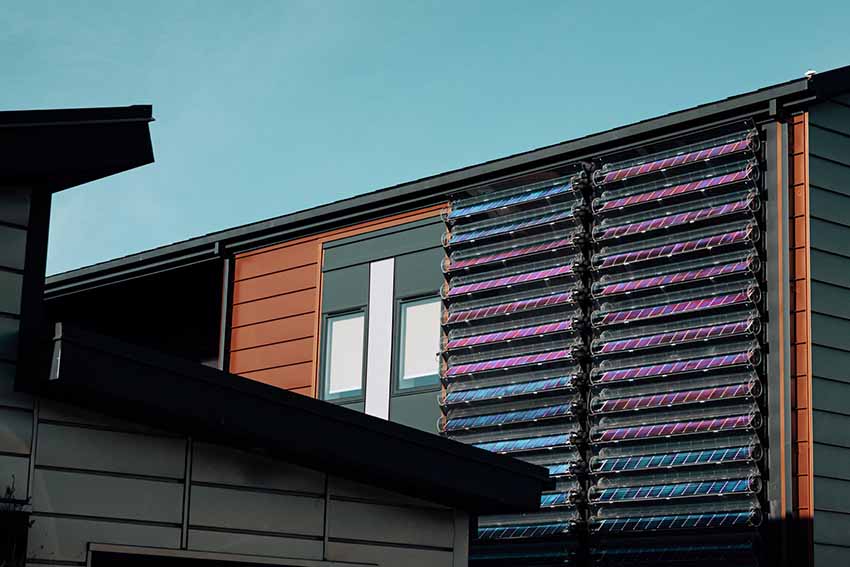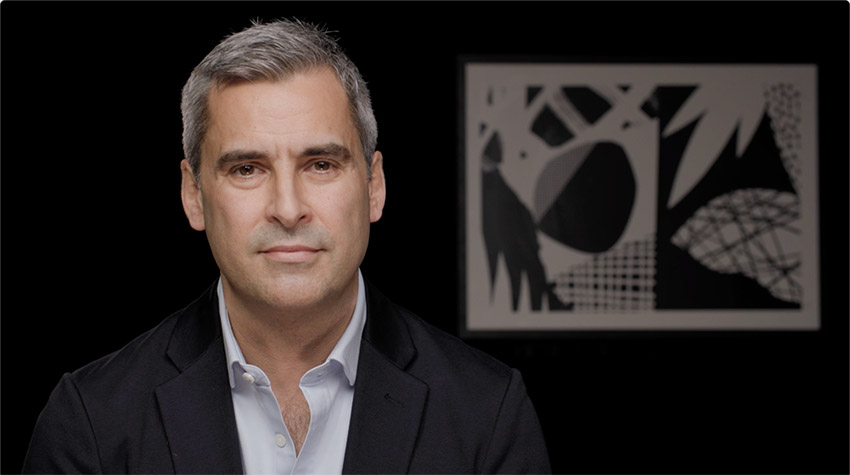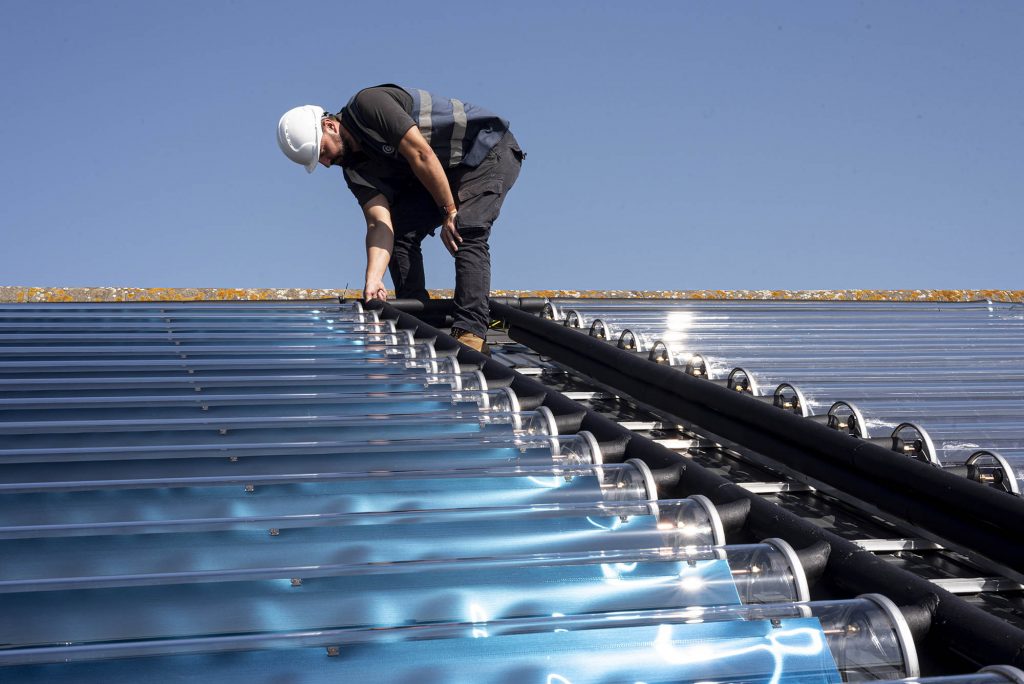Naked Energy designs, engineers and manufactures solar heat and power technology. They’ve spent years testing and refining our two core products, VirtuPVT and VirtuHOT – these are world-leading solar thermal collectors that generate heat, and in the case of VirtuPVT, also power.
Interview with Christophe Williams, CEO & Co-Founder of Naked Energy.
Easy Engineering: A brief description of the company and its activities.
Christophe Williams: I was inspired to work in renewables because of the work of my grandfather. During the fuel crisis in the 70s, he was developing early prototypes of solar, wind and wave power alongside Professor Steve Salter (inventor of the eponymous Salter duck wave energy device). I was captivated by his models when I was young and they had a profound impact on me.
When it came to founding Naked Energy 30 years later, I was inspired by his ideas and wanted to commercialise as many as possible, but it soon became clear (and I was reminded by investors) to just pick one!
Since starting the business in 2009, I’ve gone from personally being involved with the manufacturing process to heading up a team of 19 talented people. We work with a fantastic growing network of partners and are always looking to expand our network of industry experts committed to a zero-carbon future.
E.E: What are the main areas of activity of the company?
C.W: Naked Energy was founded to change energy for good. Not many people realise that heating consumes 51% of the energy we use globally. We often think of transport or electricity as the biggest offenders, but really, it’s heat.
We’re rolling out solar thermal installations around the globe – on the roofs of hotels, factories, and university buildings from South Africa to the Netherlands, Hong Kong to the United States.
Through our network of brilliant partners, we’re transforming carbon-intensive heating into sustainable solar heat solutions. We’ve got plenty more partnerships to be announced this year, and we’re always on the hunt for businesses across the world who share Naked Energy’s green vision.

E.E: What’s the news about new products?
C.W: Our VirtuHOT model recently received TÜV international certification, which was a huge milestone for the company. Getting our product to the world-leading quality that it is today and achieving TÜV certification has been a challenging process. The collectors had to endure being hit by golf balls, withstand extended periods of time in -40°C and 240°C temperatures, and were even exposed to fire. It was a rigorous process, and each time we failed a test we had to go back and improve the product.
It’s all been worth it for the international reputation – we can now honestly say we have one of the best products on the market and we have the proof to back it up.
The unique design of our Virtu products means they generate more energy from less space. They’re more compact, meaning we can install more collectors in the same space when compared to traditional PV panels, and the integrated reflectors mean they perform optimally throughout the day, not just at peak times.
E.E: What are the ranges of products?
C.W: VirtuPVT is a hybrid product that generates both electricity and heat from a single collector. It produces three to four times more energy than traditional PV panels, and the modular design makes it the world’s highest energy density solar technology.
Our VirtuHOT collector, which generates solar heat, can heat water up to 120°C, making it an ideal solution for industrial processes like food manufacturing or the leisure sector. Both technologies are proving instrumental to the decarbonisation of heat and can be installed on facades, angled or flat roofs to meet a building’s individual specifications.
The Virtu product range is ideal for anywhere that has limited roof space but high demand for heating and hot water. The compact, modular design of Virtu gives us the flexibility to fit around pre-existing solar installations or cluttered roofs, whilst their energy efficiency keeps output high.
E.E: At what stage is the solar thermal market?
C.W: The solar thermal market is developing fast. The International Energy Agency predicts solar heat systems will be used in 30% of all buildings globally by 2050, so it’s clear the market is set to experience significant growth.
These numbers mirror our own experience and perception of the market – Naked Energy’s sales pipeline is growing continuously and we’re also seeing increased interest in industrial and solar cooling applications.

These are clear indications of a flourishing market, and Europe’s market is far more mature in comparison to the UK’s. However, we’re seeing an encouraging amount of growth in our domestic market, and we’re poised to take advantage of that.
E.E: What can you tell us about solar market trends?
C.W: Overall the trend we’re seeing in the industry is an upward trajectory, this is across the full spectrum of solar technologies but particularly with solar heat.
Several countries are already taking advantage of solar heat. Israel is close to having 90% of its homes equipped with the technology, and Holland predicts 30-50% of its households will have solar thermal systems by 2050.
Denmark, Germany and Sweden among others are currently deploying over 260 solar district heating networks (SDH) across their countries. These are large scale solar thermal infrastructure that will help wean towns and cities off oil and gas. In the Netherlands alone there are 281MW of SDH in the planning process – all of which directly reduce the demand for fossil fuels.
It’s not just residential buildings set to benefit from solar heat either. We’re also seeing a sharp rise in solar heat for industrial processes. Last year, we saw more of these systems come online than at any other time in the last six years, bringing 30MW of solar heat to textile, chemical and food processing industries.
The EU is leading the way with its widespread adoption of solar heat, and as other countries realise the benefits, demand for solar thermal will only continue to grow.
E.E: What are the most innovative products marketed?
C.W: We’ve developed a product that’s genuinely cutting-edge. The fact that VirtuPVT generates both heat and electricity make it stand out from the pack – very few products on the market combine thermal with traditional photovoltaic technology.
The technology is also incredibly efficient. The compact design of Virtu means more collectors can be installed in the same space – comparative to traditional solar panels – which maximises energy generation. Naked Energy’s collectors also don’t have the risk of self-shading. They’re able to perform at maximum efficiency throughout the day.

Beyond our own innovations, our team is fascinated by the rise of Solar District Heating Networks. These are a powerful and fascinating demonstration of how entire communities can decarbonise through large-scale infrastructure projects. When paired with inter-seasonal storage such as Pit Thermal Energy Storage, these networks can provide a solar fraction of 90-100%. Solar District Heating Networks are proving to be very successful, especially in Denmark or Austria for example, and my prediction is that their popularity will only continue to grow.
E.E: What estimations do you have for 2023?
C.W: In tandem with the wider industry momentum, Naked Energy is experiencing an exciting period of growth. We have a growing global network of partners that allows us to address customers around the world, and a broad investor base with strategic input in various international markets.
Last year we secured investment from Nesta, Barclays, ELM Companies, and Big Sky Partners. The investment has enabled us to scale our operations and pursue an ambitious launch strategy in the US. The opportunity for solar thermal has dramatically increased with the passing of the Inflation Reduction Act, which is supporting local manufacturing and offering subsidies for property owners whilst incentivising on-site renewables.
With the EU now implementing the Green Deal Industrial Plan to support its local industry, the direction of travel is clear. The energy transition provides a huge opportunity to build domestic supply chains, revitalise national industries and mitigate the worst effects of climate change.
Solar thermal should be seen as an integral part of this journey in the United Kingdom. The International Energy Agency (IEA) forecasts that the number of solar thermal systems around the world will balloon from 250 million to 1.2 billion by 2050, and will directly contribute to roughly 250,000 green jobs by 2030 in Europe alone. It seems like the penny is finally dropping.

